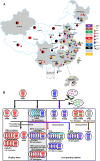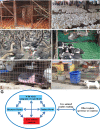Epidemiology, Evolution, and Recent Outbreaks of Avian Influenza Virus in China
- PMID: 26063419
- PMCID: PMC4524075
- DOI: 10.1128/JVI.01034-15
Epidemiology, Evolution, and Recent Outbreaks of Avian Influenza Virus in China
Abstract
Novel reassortants of H7N9, H10N8, and H5N6 avian influenza viruses (AIVs) are currently circulating in China's poultry flocks, occasionally infecting humans and other mammals. Combined with the sometimes enzootic H5N1 and H9N2 strains, this cauldron of genetically diverse AIVs pose significant risks to public health. Here, we review the epidemiology, evolution, and recent outbreaks of AIVs in China, discuss reasons behind the recent increase in the emergence of novel AIVs, and identify warning signs which may point to the emergence of a potentially virulent and highly transmissible AIV to humans. This review will be useful to authorities who consider options for the detection and control of AIV transmission in animals and humans, with the goal of preventing future epidemics and pandemics.
Copyright © 2015, American Society for Microbiology. All Rights Reserved.
Figures


References
-
- Pu J, Wang S, Yin Y, Zhang G, Carter RA, Wang J, Xu G, Sun H, Wang M, Wen C, Wei Y, Wang D, Zhu B, Lemmon G, Jiao Y, Duan S, Wang Q, Du Q, Sun M, Bao J, Sun Y, Zhao J, Zhang H, Wu G, Liu J, Webster RG. 2015. Evolution of the H9N2 influenza genotype that facilitated the genesis of the novel H7N9 virus. Proc Natl Acad Sci U S A 112:548–553. doi:10.1073/pnas.1422456112. - DOI - PMC - PubMed
Publication types
MeSH terms
LinkOut - more resources
Full Text Sources
Medical

